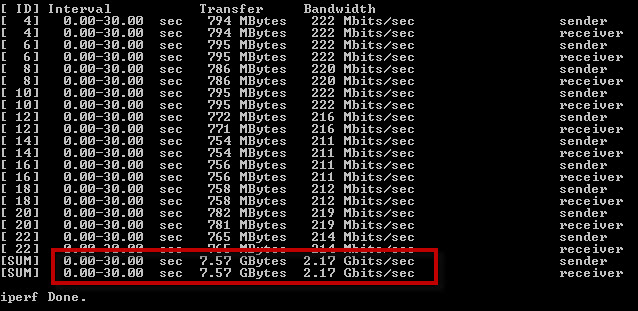May 27, 2015 Download IPERF en copy it to a folder on both servers. At the destination server open a command-prompt and run 'IPERF -s' At the source server open a command-prompt and run 'IPERF -c ' I use IPERF a lot of times. It will give you a very good output about the bandwidth used. IPERF is a well-know tool and used quite often. Jul 22, 2020 IPerf is an open-source tool designed to test network bandwidth between two network nodes. The iPerf allows to generate TCP and UDP traffic/load between two hosts.
I finally found some time to run a series of iPerf network performance tests between Windows server 2008 R2, Windows 2012 and a Linux Debian virtual machines. The tests compare bandwidth throughput between vmxnet3, e1000 going through a 1Gbit and a 10Gbit physical network card. Iperf3 is a new implementation from scratch, with the goal of a smaller, simpler code base, and a library version of the functionality that can be used in other programs. Iperf3 also incorporates a number of features found in other tools such as nuttcp and netperf, but were missing from the original iperf.
To enable IPERF QoS settings in Windows 7, more steps are required.
First of all, the same DisableUserTOSSetting key as in Windows XP must be configured:
Secondly, Windows 7 QoS settings must be allowed by domain policies. To disable that, additional REG_SZ key must be configured:
HKLMSYSTEMCurrentControlSetServicesTcpipQoS'Do not use NLA'='1'
Note that it is of REG_SZ type, not REG_DWORD:
You can copy the following lines into a text file, name it 'IPERF Win7 registry fix.cmd' and run it:

reg.exe add HKLMSYSTEMCURRENTCONTROLSETSERVICESTCPIPQoS /f
reg.exe add HKLMSYSTEMCURRENTCONTROLSETSERVICESTCPIPQoS /v 'Do not use NLA' /t REG_SZ /d '1' /f
reg.exe add HKLMSYSTEMCURRENTCONTROLSETSERVICESTCPIPPARAMETERS /v DisableUserTOSSetting /t REG_DWORD /d 0 /f
@echo+
@echo Done. Reboot the computer now.
@echo+
@pause
Thus, you escape the domain policy... The third and last step, is to override the local group policy.
Bear in mind that it is not available in Windows 7 Home edition. Start Microsoft Management Console (click Start, in Start Search box type mmc, then double-click mmc program found). Console Root is probably empty. On the File menu, click Add/Remove Snap-in. In the Add or Remove Snap-ins dialog box, click Group Policy Object Editor, and then click Add:
Now in the newly added Local Computer Policy, under Windows Settings, find Policy-Based QoS. Right-click on it and choose Advanced QoS Settings. In DSCP Marking Override tab, check Control DSCP marking... checkbox and choose Allowed to allow applications to set DSCP values independently of QoS policies:
We're almost done, reboot just in case. Wireshark will show that this setting doesn't work - packets are still sent with DSCP = 0 not matter what IPERF is trying to set.
We need to configure IPERF-specific policy. Right-click Policy-based QoS and choose Create new policy. Call it what you wish, for example IPERF QoS Policy. Specify the DSCP value you want to assign:
Insert the full path to the IPERF executable:
Specify any source or destination IP addresses:
Set protocols to both TCP and UDP:
and now new IPERF policy is completed:
Wireshark should now show it working, without a reboot!
Iperf was one of the earliest apps covered at this blog (second only to Opera) and I still happily use it. Strangely, until recently I had completely missed JPerf utility that equips Iperf with graphical interface to escape horrors of command line setup.
What it does
If you are not acquainted with Iperf – it is one of the most flexible tools to run bandwidth test, although somewhat limited by being command line utility.

JPerf comes equipped with Iperf and its only goal is to take command line out of setup picture.
It lists all of extensive options available for running Iperf in either server or client mode. In addition console feedback is shown in interface as well and there is graph that plotsbandwidthin real time when test is running.
Strong features
Aside from ease of setup it is also important that you don’t need JPerf on either or both sides of the pipe. It shows command line for settings you chose and that can be easily used with Iperf on its own.
Makes it easier to bear command line but doesn’t cut advantages of using command line.
Downsides
App is little clunky and is served in form of Java applet. Java Runtime is required for it to work and launching app is handled by provided BAT file. Not something you see a lot lately. :)
Overall
Keeps advanced (if not unmatched) functionality of bandwidth tests and complements with decent setup usability.
Downloadhttp://sourceforge.net/projects/iperf/files/